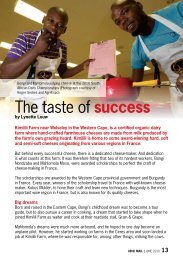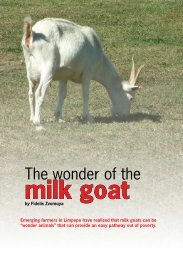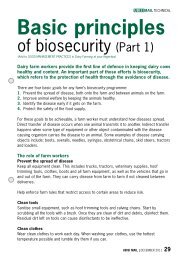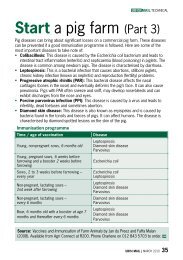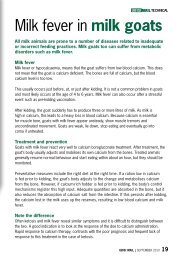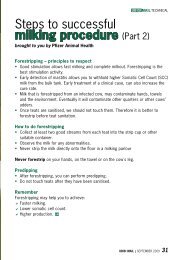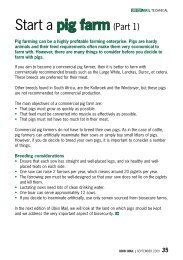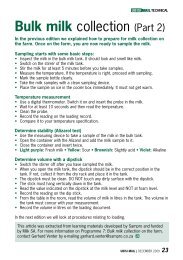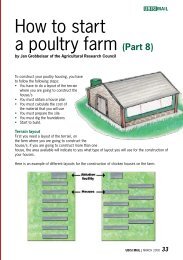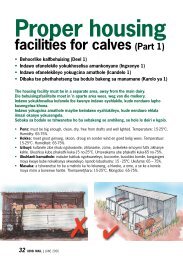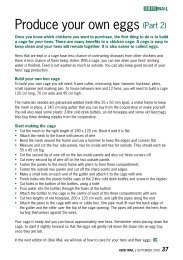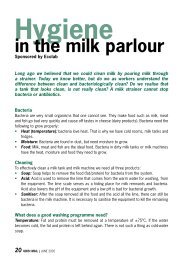for the job - Ubisi Mail Magazine
for the job - Ubisi Mail Magazine
for the job - Ubisi Mail Magazine
- No tags were found...
Create successful ePaper yourself
Turn your PDF publications into a flip-book with our unique Google optimized e-Paper software.
MAIN FEATUREThe speed of a rotary parlour can beregulated, giving <strong>the</strong> milker time to prepareeach cow and attach <strong>the</strong> milking unitThe right parlour<strong>for</strong> <strong>the</strong> <strong>job</strong>by Lynette LouwThe milking parlour is a specialised facility that can increase a farm’s milkproduction and profits. However, a milking parlour can only be successful ifit is well-designed, and provides a good environment in which <strong>the</strong> cow canbe milked and <strong>the</strong> milking team can deliver <strong>the</strong>ir best work.When choosing a milking parlour, <strong>the</strong>re are a few things to bear in mind. First of all, <strong>the</strong>type of parlour will depend on <strong>the</strong> size of <strong>the</strong> milking herd. Secondly, cost and size aretwo factors that go hand in hand. For example, a milking parlour that is sized <strong>for</strong> useonly four to six hours per day, will be more expensive to build and operate per cow, thana parlour which operates 20 to 21 hours per day.The <strong>for</strong>mation in which cows stand in <strong>the</strong> parlour, or <strong>the</strong> shape of <strong>the</strong> <strong>for</strong>mations inwhich <strong>the</strong>y are grouped, indicate <strong>the</strong> name of <strong>the</strong> type of milking parlour. The followingare <strong>the</strong> most common milking parlour types used in South Africa.4 UBISI MAIL | MARCH 2009
MAIN FEATURE• The stall gates are expensive toinstall and are quite noisy.• Operators can become quite tired,due to udders being almost 2,5metres apart.• A large area has to be washed and<strong>the</strong> upright stall construction canmake cleaning difficult.Rotary milking parloursCows are milked on a rotating, elevatedcircular plat<strong>for</strong>m. Cows stand in anabreast <strong>for</strong>mation. They can facetowards <strong>the</strong> inner or <strong>the</strong> outer edge of<strong>the</strong> plat<strong>for</strong>m. The abreast type takesup <strong>the</strong> least space per number of cowsmilked. The milker stands in one placeoutside <strong>the</strong> plat<strong>for</strong>m and <strong>the</strong> cows aremoved to him.The plat<strong>for</strong>m speed can be regulated,giving <strong>the</strong> milker time to prepare eachcow and attach a milking unit. Up to 40cows can be milked on a rotary unit.Rotary parlours normally consist of acircular steel plat<strong>for</strong>m. The plat<strong>for</strong>mrotates on rollers and is driven byelectric or hydraulic motors.The tandem sidegate parlour is suitable<strong>for</strong> smaller herds, but can accommodateup to 200 cowsThe basic swingover herringbone parlouris very popular in pasture-based dairyfarmingAdvantages• This parlour accommodates a steady output of cows.• Operators do not have to walk much.Disadvantages• This system is quite expensive to maintain.• There is a big risk of mechanical failure, which can halt <strong>the</strong> entire milkingprocess.• The rotary parlour cannot be expanded as far as building is concerned.• Over-milking or under-milking can occur. UMUBISI MAIL | MARCH 2009 7



